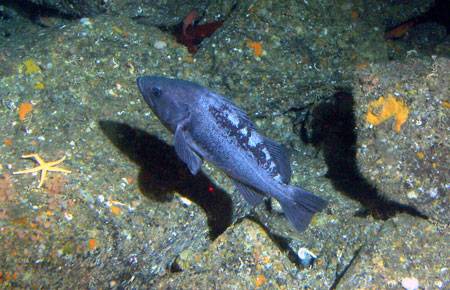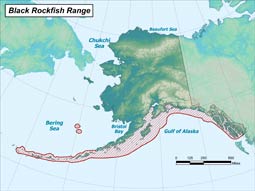Black Rockfish
(Sebastes melonops)
Printer Friendly

Did You Know?
Black rockfish are one of the 30 species of rockfish in Alaska.
General Description
Adult black rockfish (Sebastes melanops) have a mottled gray-black body often with dark stripes from the eye to the gill plate. These fish are characterized by having a bass-shaped body, a large mouth, and spinous dorsal fin. The spines are venomous and may cause pain or infection; however, are not extremely toxic. Black rockfish may be distinguished from similar species, such as dark (S. ciliatus) and dusky (S. variabilis) rockfish, by the white belly and lack of pores or knob on the lower jaw. Adults may reach a maximum weight of 5 kg (11 lbs) and maximum length of 69 cm (27.6 in) with females reaching larger sizes than males. Newly settled black rockfish may be orange to dark brown in coloration, and older juveniles are mottled gray and black with a black spot on the posterior portion of the spinous dorsal fin.
Life History
Growth and Reproduction
In Alaska, black rockfish become sexually mature at 6 to 8 years of age (38–42 cm). Black rockfish produce between 125,000 to 1,200,000 eggs per season. After mating, females will store sperm for several months until fertilization. Larvae are released alive from January to May along the Pacific coast. Black rockfish live to about 50 years.
Feeding Ecology
Black rockfish are an opportunistic predatory fish that typically feed in the water column on zooplankton, Dungeness crab larvae (Cancer magister/ syn. Metacarcinus magister), and fish species, such as herring (Clupea harengus), sand lance (Ammodytes hexapterus), and Puget Sound rockfish (Sebastes. empheaus). However, they may also feed on benthic species such as crustaceans and octopi.
Predators of young black rockfish include sablefish (Anoplopoma fimbria), Pacific halibut (Hippoglossus stenolepis), other fish species, and pigeon guillemot (Cepphus columba).
Migration
Black rockfish are more mobile than many other rockfish species. However, acoustic tagging studies performed in Oregon indicate they have a small home range of about 0.55 square km. Black rockfish may take trips outside their home range during the reproductive season or to take advantage of food available seasonally. Tagging studies performed in Alaska indicate an average distance of 4 km travelled from release to recovery location. In addition, acoustic tagging studies indicate that black rockfish perform vertical migrations, often with sunrise or sunset.
Range and Habitat
Black rockfish range from Amchitka Island in the Aleutian Islands to southern California. They are also rarely observed around the Pribilof Islands.
Black rockfish occur in the waters above the continental shelf at the surface to depths of 366 m, but usually are found in water shallower than 150 m. Generally, when black rockfish are observed at the surface they are in feeding aggregations. Black rockfish are found in rugged, rocky habitat, often above pinnacles and/or in high current locations. Black rockfish are considered a pelagic rockfish species and are generally found in large schools in the water column; however, they are also observed to rest on the bottom. They are observed to school with other species such as yellowtail, widow, or dusky rockfish.
Status, Trends, and Threats
Status
Although stock assessments do not exist for black rockfish stocks in Southeast Alaska or Central Region, there is no concern for these stocks at this time, because the directed fisheries for black rockfish and pelagic shelf rockfish in these areas are small with reduced fishing effort in recent years. In the Westward region (Kodiak area) directed fisheries for black rockfish have been conservatively managed in the past, and a stock assessment program in this region is being developed based on acoustic techniques as an index of abundance with a goal of incorporating this data into an age-structured model in the future.
Threats
The life history characteristics, physiology, and behavior of black rockfish make them susceptible to overfishing. Black rockfish are a long-lived species, which grow slow, and mature late. They are found in the nearshore, have a small home range, and occur in schools over rugged, rocky bottom or at the surface in large feeding aggregations; these behaviors may make them vulnerable to intense targeted fisheries. However, the schooling behavior and small home range of black rockfish also make them good candidates for marine reserves.
Management of black rockfish is difficult due to limited resources, and the difficulty in performing assessments in their habitat, nearshore waters with a rugged and rocky substrate.
Black rockfish often die from barotrauma (physical injury due to changes in pressure) after being caught by fishermen. These fish do not have a vent on their swim bladder (an air-filled organ used to adjust buoyancy). Consequently, as they are brought to the water’s surface from depth, the pressure change causes the air in their swim bladder to expand which can displace other organs and cause injury. The visible signs of barotrauma may be bulging eyes, tight gill membranes, or the esophagus protruding from the mouth; however, additional internal injuries may occur. Anglers are strongly discouraged in puncturing the esophagus that is protruding from the mouth, which may result in delayed mortality.
Research performed by the Alaska Department of Fish and Game and Oregon State University shows that recompression of rockfish is promising for short-term survival; additional research is being conducted to determine the effects of barotrauma on long-term survival. Recompression of rockfish can make the expanded gas contract and external signs of barotrauma disappear. Currently the Alaska Department of Fish and Game encourages anglers to avoid rockfish habitat when fishing for other species and does not have a current recommendation regarding recompression. The Oregon Department of Fish and Wildlife recommends recompressing fish using an inverted barbless hook or a weighted cage with a trap door to lower the fish to depth.
Fast Facts
-
Size
Maximum weight of 5 kg (11 lbs) and maximum length of 69 cm (27.6 in) -
Lifespan
About 50 years -
Range/Distribution
Aleutian Islands to southern California and rare occurrences around Pribilof Islands -
Diet
Zooplankton, crab larvae, and fish such as herring and sand lance -
Predators
Juveniles preyed on by sablefish, Pacific halibut and pigeon guillemots -
Reproduction
Black rockfish give birth to live young after internal fertilization -
Remarks
Managed by the State of Alaska
Did You Know?
- Black rockfish are one of the 30 species of rockfish in Alaska.
- Black rockfish live as long as 50 years.
- Rockfish have venomous spines, though their venom is relatively mild and seldom causes more than minor pain or swelling.
- Black rockfish are extremely vulnerable to overfishing.
- Black rockfish give birth to live young.
Uses
In Alaska, directed commercial fisheries for pelagic rockfish, with black rockfish generally as the primary target, occur in the areas of Kodiak, Chignik, South Alaska Peninsula, Lower Cook Inlet, and Southeast Alaska. Black rockfish tend to be marketed as domestic fresh fillets or frozen in the round and shipped to Asian markets. Black rockfish are also targeted by sport fishermen in Alaska.
Management
More than 30 species of rockfish from the genera Sebastes and Sebastolobus are harvested in the U.S. Exclusive Economic Zone off Alaska. For management purposes rockfish in the Gulf of Alaska and Bering Sea Aleutian Islands are divided into management assemblages based on their habitat, habits, distribution and, in some cases, to reduce the possibility of overharvest of certain more economically valuable species. Rockfish inhabiting the Gulf of Alaska are separated into three ecological groups: demersal shelf, pelagic shelf, and slope rockfish. Black rockfish are categorized with pelagic shelf rockfish (Sebastes sp.); this assemblage includes dusky (S. variabilis), dark (S. ciliatus), widow (S. entomelas), yellowtail (S. flavidus), and blue rockfish (S. mystinus). Generally groundfish fisheries in the U. S. Exclusive Economic Zone (EEZ; 3–200 nm offshore) are federally managed; however in 1998 management jurisdiction for black and blue rockfish was transferred to the State of Alaska. In the pelagic shelf rockfish assemblage, management emphasis is placed on black rockfish as it is the only species in this group with directed fisheries in state waters.
Fisheries targeting pelagic shelf rockfish or black rockfish occur in Kodiak, Chignik and the South Alaska Peninsula in the Westward region, in Lower Cook Inlet in Central Region, and in Southeast Alaska. Pelagic shelf or black rockfish may be harvested with hand troll or mechanical jig in all regions, and in Southeast Alaska dinglebar is an additional legal gear type. The directed fisheries in Central Region and in Southeast Alaska are small and conservatively managed using guideline harvest limits by area. The fisheries in the Westward Region (Kodiak area) have been managed conservatively using historic catch data, trip limits, and daily bag limits in the past. A stock assessment program is being developed in Westward Region using acoustics as an index of abundance with a goal to incorporate this data into an age-structured model in the future.
Research
In Southeast Alaska, tagging studies have been performed on black rockfish. A total of 4,590 black rockfish were tagged and released with dart tags from 1996–2002. The majority of these fish were released around the north side of Kruzof Island. A total of 47 fish were recovered with an average distance of 4 km between release and recovery locations. Fish were recovered at distances of less than 1 km to 15 km from their release locations.
The Alaska Department of Fish & Game sport fish division is conducting research on recompression of rockfish caught by anglers. Rockfish that are brought up from depth are often at risk to death or injury due to changes in water pressure due to expanding gas in their swim bladder. Research conducted by both the Alaska Department of Fish and Game and Oregon State University show promise in increased short term survival after recompression. By releasing the rockfish at depth, the expanded gas may contract and external signs of barotrauma may disappear. More research is being conducted to determine the effects of recompression on long term survival.
More Resources
General Information
- Rockfish Conservation
- Angler's Guide to the Rockfishes of Alaska: Biology and Fishery Management
- Guide to Northeast Pacific Rockfish: Genera Sebastes and Sebastolobus
- Rockfish — Wildlife Notebook Series (PDF 50 kB)
- Kodiak Area Fishery Management Plan for Black Rockfish Fisheries (PDF 540 kB)
- Oregon State Research on Barotrauma and Rockfish Recompression
- Southeast Alaska Black Rockfish Research
- North Pacific Fisheries Management Council (NPFMC)

